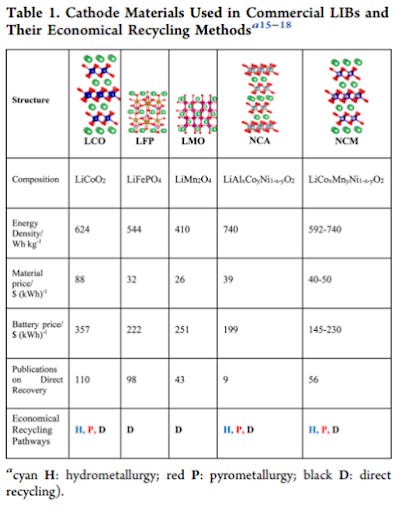Lithium-Ion Batteries Recycling
Lithium-ion
Battery Recycling
Introduction and uses:
Lithium-ion batteries are amongst the most commonly
used in the world, with the usage varying from handheld small electronic
devices such as electronics, toys, wireless headphones to electric cars and
energy storage systems we use today. These batteries are greatly preferred due
to their high energy density, i.e. the ability to store energy efficiently in a
given amount of space. Lithium batteries are smaller and lighter than other
types of batteries, and have a greater energy density, leading to its greater
use compared to other kinds of batteries. Lithium cells are of two types- one
made of lithium metal which are single use and non-rechargeable, and the other
which are made out of lithium and polymer and are multi use and
non-rechargeable.
Structure of a li-ion battery:
A lithium-ion battery comprises of a cathode, an anode
and an electrolyte. The anode is usually made of carbon(graphite), the cathode
of a metal oxide (such as lithium cobalt oxide, lithium manganese oxide) and the
electrolyte usually being lithium salt in an organic solvent. The anode and
cathode do not short due to a separator, and their electrochemical roles
reverse depending on the direction of flow of current through the cell.
When in use, during discharge, the lithium ions are which
stored in a mesh of the graphite anode, travel through the electrolyte, while
the electrons travel through the external circuit, powering it; and the two
recombine at the cathode. Thus, an oxidation half reaction takes place at the
anode while a reduction half reaction takes place at the cathode.
During charging, the reverse process takes place, with
the electrons travelling from the cathode to the anode from the external
circuit and the lithium ions move across the electrolyte towards the anode.
Future Problems:
Lithium ion batteries often contain many such
important metals like cobalt, nickel, manganese, which are necessary and are
considered as critical minerals, due to their strategic and economical
importance, with their supply being at high risk due to problems in the supply
chain and no easy substitutes being available. Outright disposal of these
batteries leads to loss of these recoverable minerals, as well as posing a
health and fire hazard if not disposed properly.
In the past few years, with over 1,80,000 metric tons
of Li-ion batteries being available worldwide for recycling, a little over half
were recycled. Thus, there is a need for recycling of these batteries in order
to prevent excessive mining for these minerals, saving the environment and
thereby lies an opportunity for recycling of these batteries.
Process:
Recycling of these batteries begins with separating
them and to sort them by the type of battery, as each type of chemical make-up
requires its own process. Most of the recycling of these batteries occurs in
one of these paths:
1. 1. Direct
method: Here, the battery is disassembled, and the cathode is separated, as it
needs the reconditioning. A lithium source is then added, in order to
replenish the used cathode, which is then followed by the process of
calcination. This method is the most widely used, as it allows recyclers to
keep the crystal structure intact with lower energy, reagents and fixed
facility costs, while having a smaller impact on the environment than
hydrometallurgy and pyrometallurgy. It has a short recovery route and is
environmentally friendly, along with having a high recovery rate and low energy
consumption. However, it has high operational and equipment requirements and
incomplete recovery.
2. 2. Pyrometallurgy:
This method is most used when there exist rare earth minerals such as cobalt,
etc which need to be recycled. In reductive smelting, after pre-treatment,
battery materials are heated under vacuum or inert atmosphere to convert metal
oxides to metal alloy containing cobalt, nickel, iron, slag containing lithium
and aluminium. This is also accompanied by the emission of greenhouse
gases. The pre-treatment methods often
are crushing and shredding. The end product is the recovered metal allow which
can be further processed and used according to requirements. IT is a highly
efficient process with simple operation and short flow. However, energy
consumption is high, with waste gas being formed and low efficiency of recovery
rate.
3. 3. Hydrometallurgy:
Hydrometallurgical methods use primarily aqueous solutions to extract and
separate metals from the batteries. The pre-treated battery materials (with
aluminium and copper parts removed) are most often extracted with H2SO4 and
H2O2, although HCl, HNO3, and organic acids including citric and oxalic acids
are commonly used. Once metals have been extracted into solution, they are
precipitated selectively as salts using pH variation or extracted using organic
solvents containing extractants such as dialkyl phosphates or phosphinates. The
advantages of this process being that the recovery rate and product purity is
high, with energy consumption and waste gas emission being low. However, it is
a long process with ample wastewater being formed.
In many cases, we see that
pyrometallurgy and hydrometallurgy is often used together.
Economic Outlook:
A 2022 report from McKinsey says that the entire
Li-ion battery chain, from mining to recycling could grow over 30% in value,
reaching a value of $400 billion and a market size of 4.7 TWh. With
governmental norms in place and an overall push for more reusing and recycling,
along with the unstable supply chain for various metals required in batteries
such as nickel and cobalt, it is essential to develop recycling of lithium-ion
batteries on a large scale in order, as the future requirements are incredibly demanding
and vital. By 2040, the recycling industry alone could generate revenues of
over $40 billion and have a profit pool of $6 billion.
By Vedant Banthia (Tech Tuesday, COEP BLOGS)
1. Lithium-Ion
Battery Recycling & Overview of Techniques and Trends
3. https://www.epa.gov/recycle/used-lithium-ion-batteries
4. https://spectrum.ieee.org/lithiumion-battery-recycling-finally-takes-off-in-north-america-and-europe



Comments
Post a Comment